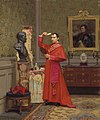This article needs additional citations for verification. Please help improve this article by adding citations to reliable sources. Unsourced material may be challenged and removed.Find sources: "Anti-clerical art" – news · newspapers · books · scholar · JSTOR (June 2015) (Learn how and when to remove this template message)

Anti-clerical art is a genre of art portraying clergy, especially Roman Catholic clergy, in unflattering contexts.[1] It was especially popular in France during the second half of the 19th century, at a time that the anti-clerical message suited the prevailing political mood. Typical paintings show cardinals in their bright red robes engaging in unseemly activities within their lavish private quarters.
Nineteenth and early twentieth century artists known for their anti-clerical art include Francesco Brunery, Marcel Brunery, Georges Croegaert, Charles Édouard Delort, Jehan Georges Vibert, Jules Benoit-Levy, Adolphe Henri Laissement and Eduardo Zamacois y Zabala.




